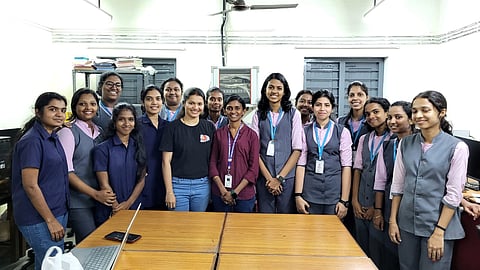

“We started from a vacuum,” says Lizy Abraham, the principal investigator of the WESAT (Women Engineered Satellite) developed by an all-female team and set to be launched by the Indian Space Research Organisation (ISRO) as a payload in the upcoming 60th Polar Satellite Launch Vehicle (PSLV) mission.
The Lal Bahadur Shastri Institute of Technology for Women (LBSITW) in Thiruvananthapuram handed over the satellite to the Vikram Sarabhai Space Center (VSSC) team on December 4. This PSLV is scheduled for launch in the first week of January, but the date has not yet been fixed.
The payload would be used to study ultraviolet (UV) radiation. It would measure UV rays in space and on earth's surface and their influence on the warm temperatures and climate change phenomena in Kerala.
The project kicked off in 2020 but the LBSITW space club had been weighing areas of study from 2017 itself. “We zeroed in on the study of UV intensity around 2020. We submitted a proposal and have held around 25 meetings with ISRO and VSSC in the last three years,” Lizy said.
The WESAT project also intends to provide UV alerts to people and make them adopt precautionary methods to protect themselves from harmful radiation. “In our country, we do not have a system to alert people about UV radiation, which can seriously harm our skin. The World Meteorological Organisation decides levels of the UV and if it is higher than a particular level, it is harmful. Some countries give alerts to their people about UV radiation. In Kerala, we do not have any authentic UV radiation map. So, we aim to create a UV radiation map and raise awareness among the public,” Lizy said.
They chose the field of UV intensity measurement as they were unable to find any truthful source that measures UV intensity through their research, said Lizy.
The UV Index tells how much ultraviolet radiation is around at the ground level and the potential harm it can cause your skin. Too much exposure can even lead to skin cancer.
The WESAT team has set up a website where the public can see the live data of UV intensity of Thiruvananthapuram city from the ground monitoring station of the campus. After the satellite is launched additional data would be available.
Space club to satellite engineering
The space club of the institution was what made developing the satellite possible. The students started the space club to do something apart from academics. When it began in 2017, the club had 40 students.
For the last three years, the space club had been focused only on developing the payload and the faculty and students worked day and night to accomplish the mission. Around 250 students from different batches and three faculty worked on the project.
“We did not have any model to refer to, nobody to approach for help. We started from scratch and worked extremely hard to achieve this milestone in our lives. I am so excited and relieved. Last week, on December 4 our payload passed all the tests from ISRO and qualified for the launch. We all are set to go to Sriharikota for the satellite integration into the PSLV rocket,” Lizy said.
“In the initial stages, we did not know what to do and after several discussions, we concluded, that is what WESAT is,” said Kousalya, an alumna of LBSITW, who worked for WESAT in the initial stages.
The lack of funding was the major difficulty they faced during the project. After signing the Memorandum of Understanding with the Department of Space they did not get funds immediately. “It was exceedingly difficult to convince the people. Because from their point of view, we were a normal engineering college and going to make a satellite. but we were 110 percent confident,” Lizy said.
The WESAT cost around Rs 30 lakh to build out of which Rs 10 lakh came from the Union government and Rs 14.4 lakh from the state government. “We were already aware of the budget constraints, so we went for an optimised design,” Lizy said.
Proud and happy
Dr Reshmi, a faculty member of WESAT said satellite payload development and setting up the ground monitoring station were sophisticated processes. “We faced a lot of challenges. When Covid struck, everything was shut down and Lizy conducted several meetings to revive the initiative. I am indebted to her. The students worked even on weekends for this,” she said.
The students and the alumni also shared their excitement and happiness. “From childhood, I loved space science. I took engineering only for the sake of a secured job. However, here also I got a big opportunity. Now I am so happy and proud. Our seniors gave this spark, and we did a detailed study on the subject. Our juniors are making this a reality,” said Reshma, a former student who worked on the project in its initial days.
Kousalya said they could only complete the documentation part of the project due to the lack of funds. “I am extremely happy that my juniors worked for that, and it is set for launch,” she said.
Devika, a final-year student of Applied Electronics and the student coordinator of the WESAT said this was the dream project of their seniors. “We were only implementing it. If we have doubts or difficulties, they are always ready for help,” said Devika.
It also gave students like Devika the opportunity to interact with scientists at VSSC. “This project also improved my knowledge and communication skills as one of the tasks was presenting PPTs to the ISRO and VSSC officials,” she said.
“We want to go to the launch site but due to the university exam, we are not sure. However, we are extremely happy to be part of this project,” said Surya, another student coordinator, sharing her excitement.